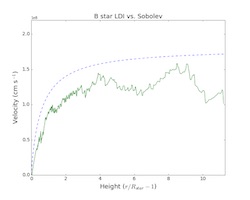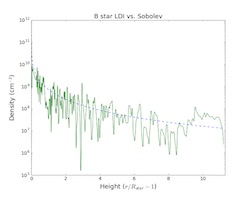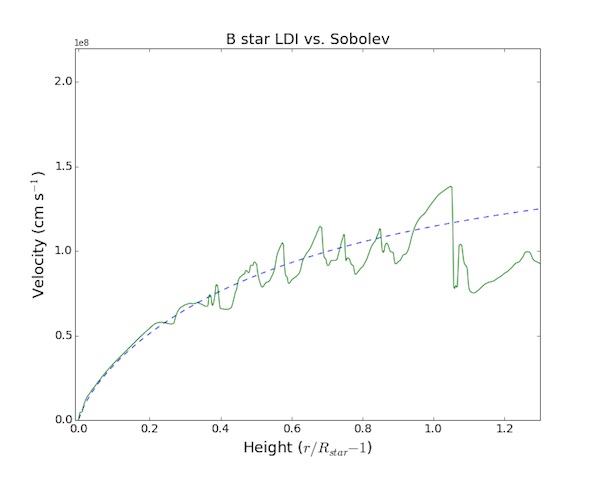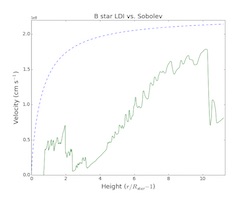Hydro Simulations of Radiation-Driven Winds
low mass-loss rate wind
11 Apr 2016
These simulations are identical to the ones shown below (with Qmax = 0.1) but without radiative cooling.
Snapshot of velocity, density, and temperature
Note that, as expected, the filling factor of hot gas is much higher and, consequently, the velocity is significantly lower. Maybe not low enough to produce lines as narrow as what we see with Chandra, but narrower than the case with radiative cooling at least.
29 Feb 2016
We relaxed a Sobolev solution for a wind based on a B0.5V star's parameters (taken from theta Car's theoretical values in Cohen, Cassinelli, and MacFarlane 1997). Not the most up-to-date nor specifically determined for theta Car, but probably close (modulo the weak-wind phenomenon). The adopted stellar parameters are tabulated in the INDAT file for the hydro run: L/Lsun = 2.8e4, R/Rsun = 6.5, M/Msun = 16.0, Teff = 28800 K. Note that we also adopted CAK/Gayley wind parameters of alpha = 0.55 and Q = 700.
Below, we show the relaxed Sobolev model along with a model including the LDI (ifrc = 3). The mass-loss rate of the Sobolev model, empirically, is 2.9e-8 Msun/yr. Note that we used Qmax = 0.1, and also got a similar mass-loss rate for (significantly) higher Qmax values. The terminal velocity is about 1700 km/s.
Snapshot of velocity
Snapshot of velocity: zoom in on wind base
Snapshot of density
Snapshot of temperature
The post-shock cooling lengths are, empirically, quite short. We have to look into the radiative cooling in these simulations and make some adjustments.
Qmax = 1 (rather than 0.1 used above)
The adopted stellar parameters are tabulated in the INDAT file and are all the same as the above simulation, except for Qmax. The Sobolev solution gives a nice smooth steady-state v(r) with a mass-loss rate of 3.6e-8 Msun/yr.
However, the with the LDI turned on (ifrc = 3), the structure is extreme (the snapshot here is from 380 ks into the simulation, when the program halted due to the time-step becoming too small).
Snapshot of velocity, density, temperature:
last modified: 11 April 2016









